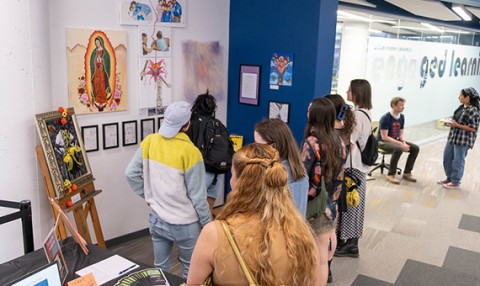From Grammys to Soil Symphonies
The second event saw participants through a series of faculty showcase presentations about their work and publications, both on campus, and from around the world:
Path to the Palace and Escapades in Caves
Carrie Osgood
Carrie Osgood shared her creative journey throughout 2023 into 2024, from her Data Atlas of the World to the creative process and inspiration that resulted in her pair of newly published allegorical picture books for all ages, Path to the Palace and Escapades in Caves. She presented her creative evolution from designing infographic world maps to producing conceptual narratives to writing original short stories visualized with her own photography. Her assorted projects helped her develop her latest venture, YourStoryGPS.com, where her books are available for purchase.
STILLPOINT
Mark Rabideau
What might be possible if we were to reposition creativity at the center of all that we do? Western classical music has fallen (over the past 120-years) away from creative practices in favor of re-creative practices. My creative activity argues for a return to creative practices. The result is STILLPOINT (New Amsterdam, 2023), a project five years in the making, made its debut on Billboard Magazine’s Classical Crossover chart at #6 and the Traditional Classical chart at #13 and was listed among “The Best Contemporary Classical on Bandcamp (August 2023) and received a Grammy for Best Contemporary Classical Composition (Jesse Montgomery, Rounds) among other accolades.
RePeat – A Look and Listen at Post-Extraction Peatland
Anne Yoncha
My work combines experimental art + ecological science to explore mechanics of plant physiology. By translating these processes into artworks, I aim to build affinity with unfamiliar ecologies apparently out of sight or possessing different temporalities than our own. My practice combines digital sensing technology, such as bio-data sonification, and analog processes including painting with ink I make from locally-sourced plant matter – so the materials used in the piece add another layer of data. When public understanding of ecological problems is limited, creative artists have been historically successful in uncovering background narratives, thereby shaping how scientifically-declared emergencies are perceived and acted upon. How do we balance a sense of urgency in the time of climate change with potential unintended consequences of our interventions?
My History, My Rules
Izzy Lozano
I hope what I got across was how the power of art can help us process feelings of identity, purpose, and loss. How art has the power to reshape the mind and give it an accurate map to escape mental poverty.












